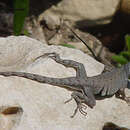en
names in breadcrumbs


This species has also been called Holbrookia texana.
IUCN Red List of Threatened Species: least concern
The Texas earless lizard is an insectivore, eating both adult and larval forms of insects such as beetles and grasshoppers (Barker and Garrett 1987). Juvenile earless lizards consume smaller prey items than do adults. This may be attributed to the inability of juveniles to handle large prey items.
This species is found just west of Fort Worth and Austin to the eastern Trans-Pecos area in Texas and into Arizona and Northern Mexico. C. texanus is absent from the eastern part of Texas, the Lower Rio Grande Valley and the Panhandle (Bartlett and Bartlett 1999).
Biogeographic Regions: nearctic (Native )
Cophosaurus texanus texanus is a terrestrial lizard which inhabits rocky areas such as desert flats, streambeds and limestone cliffs (Barker and Garrett 1987). Juveniles use rock perches more frequently than adults .
Terrestrial Biomes: desert or dune
This lizard ranges from about 2 and 3/4 to 7 and 1/4 inches from snout to tip of the tail (Barker and Garrett 1987). However, females are smaller than males. Skin coloration depends on habitat but the dorsal ground color is usually from gray to brown to reddish with head, tail, body and legs sprinkled with small light spots. The tail is mostly black underneath with dark bars on top and on the limbs of the animal. The male and female are sexually dimorphic: the male has two distinct black lines in a field of blue and yellow, anterior to the hind legs that wrap onto the venter and stop abruptly. The females and juveniles of the species have a distinct dark stripe on the back side of each thigh, surrounded by a lighter color. Pregnant females take on a pink coloration on their flanks. In both sexes, the tail and body are slightly flattened and no external ear openings are present (hence, their common name) (Bockstanz and Cannatella 1998). C. texanus has two throat folds, fairly large eyes and twenty-seven or fewer feomoral pores. They are also characterized as having shorter forelegs than hind legs and fairly long toes (Barker and Garrett 1987).
The eggs of C. texanus are laid from March to August and take about fifty days to hatch (Bartlett and Bartlett 1999). Some evidence suggests that these lizards may lay three clutches in a season (Howland 1992). The young are precocial and are about two inches long at hatching. The Texas earless lizard rarely reaches two years of age in the Central Texas area (Howland 1992).